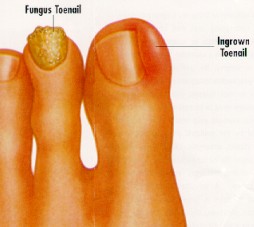Foot Surgery
Many foot problems do not respond to "conservative" management. Your podiatric surgeon can determine when surgical intervention may be helpful. Often when pain or deformity persists, surgery may be appropriate to help alleviate them, or to restore the function of your foot.
Bunions
A common deformity of the foot, a bunion is an enlargement of the bone and tissue around the joint of the big toe. Heredity frequently plays a role in the occurrence of bunions (especially among women), as it does in other foot conditions. when symptomatic, the tissue may become red, swollen, and inflamed, making shoe gear and walking uncomfortable and difficult. If conservative care fails to reduce these symptoms, surgical intervention may be warranted. Your podiatric surgeon will determine the type of surgical procedure best suited for your deformity, based on a variety of information which may include X-rays and gait examination.

Hammertoes
A hammertoe deformity is a contracture of the toe(s), frequently caused by an imbalance in the tendon or joints of the toes. Due to the "bending" effect of the toe(s), hammertoes may become painful secondary to footwear irritation and pressure. Corn and callus formation may occur as a hammertoe becomes more rigid over time, making it difficult to wear shoes. Your podiatric surgeon may suggest correction of this deformity through a surgical procedure to realign the toe(s).

Neuroma
An irritation of a nerve may produce a neuroma, which is a benign enlargement of a nerve segment, commonly found between the third and fourth toes. Several factors may contribute to the formation of a neuroma. Trauma, arthritis, high-heeled shoes, or an abnormal bone structure are just some of the conditions that may cause a neuroma. Symptoms such as burning or tingling to adjacent toes and even numbness are commonly seen with this condition. If conservative treatment does not relieve the symptoms, then your podiatric physician will decide based on your symptoms whether surgical treatment is appropriate.

Bunionette (tailor's bunion)
A protuberance of bone at the outside of the foot behind the fifth (small) toe, the bunionette or "small bunion" is caused by a variely of conditions including heredity, faulty biomechanics (the way you walk) or trauma, to name a few. Pain is often associated with this deformity, making shoes very uncomfortable and at times even walking becomes difficult. If severe and conservative treatments fail to improve the symptoms of this condition, surgical repair may be suggested. Your podiatric surgeon will develop a surgical plan specific to the condition present.

Toenail Deformities
Ingrown or deformed toenail tissue may be severe enough to warrant surgical treatment. Removal of part or all the nail may be necessary, depending on the deformity. Sometimes soft tissue near or at the nail plate must be removed to adequately treat specific conditions of the toenail. Your podiatric physician will decide the surgical procedure best suited to treat your nail condition.

Bone Spurs
A bone spur is an overgrowth of bone as a result of trauma or reactive stress of a ligament or tendon. This growth can cause pain and even restrict motion of a joint, depending on its location and size. Spurs may also be located under the toenail plate, causing nail deformity and pain. Surgical treatment and procedure is based on the size, location, and symptoms of the bone spur. Your podiatric physician will determine the surgical method best suited for your condition.
Preoperative Testing and Care
As with anyone facing any surgical procedure, those undergoing foot and ankle surgery may require specific tests or examinations before surgery to improve a successful surgical outcome. Prior to surgery, the podiatric surgeon will review your medical history and medical conditions. Specific diseases, illnesses, allergies, and current medications need to be evaluated. Other tests that help evaluate your health status may be ordered by the podiatric physician, such as blood studies, urinalysis, EKG, X-rays, blood flow studies (to better evaluate the circulatory status of the foot/legs), and biomechanical examination. A consultation with another medical specialist is sometimes advised by a podiatric physician, depending on your test results or a specific medical condition.
Postoperative Care
The type of foot surgery performed determines the length and kind of aftercare required to assure that your recovery from surgery is rapid and uneventful. The basics of all postoperative care involve to some degree each of the following: rest, ice, compression and elevation. Bandages, splints, surgical shoes, casts, crutches, or canes may be necessary to improve and ensure a safe recovery after foot surgery. A satisfactory recovery can be hastened by carefully following instructions from your podiatric surgeon.